| 従来、日本の工業の原動力は人力・牛馬・水車までだった。横須賀製鉄所ははじめから蒸気機関を原動力としていたから「蒸気機関を原動力とする日本最初の総合工場」といえる。まさに日本の産業革命の地である。司馬遼太郎が「日本の近代工学のいっさいの源泉」(「三浦半島記」)と書いたのは、このことを指す。 | In the past, the driving force of Japanese industry was human power, cattle and horses, and even water wheels. Since the Yokosuka Ironworks was powered by steam engines from the beginning, it can be called "Japan's first integrated plant powered by steam engines. It is truly the site of Japan's industrial revolution. This is what Ryotaro Shiba meant when he wrote that it was "the source of all modern engineering in Japan" (Miura Peninsula Chronicles). |
| 横須賀造船所の建設にあたり、ヴェルニーはレンガを造船所内の小海の土で焼いて建物に用いた。「ヨコスカ製銕所」と右横書きで刻印されたこのレンガは、造船所の建物の他に、灯台建設資材としても使われた。 | When building the Yokosuka Shipyard, Verney baked bricks from the soil of Koumi sea near the shipyard and used them for the building. The bricks, stamped with the words "Yokosuka Ironworks" on the right side, were used not only for the shipyard buildings but also for lighthouse construction. |
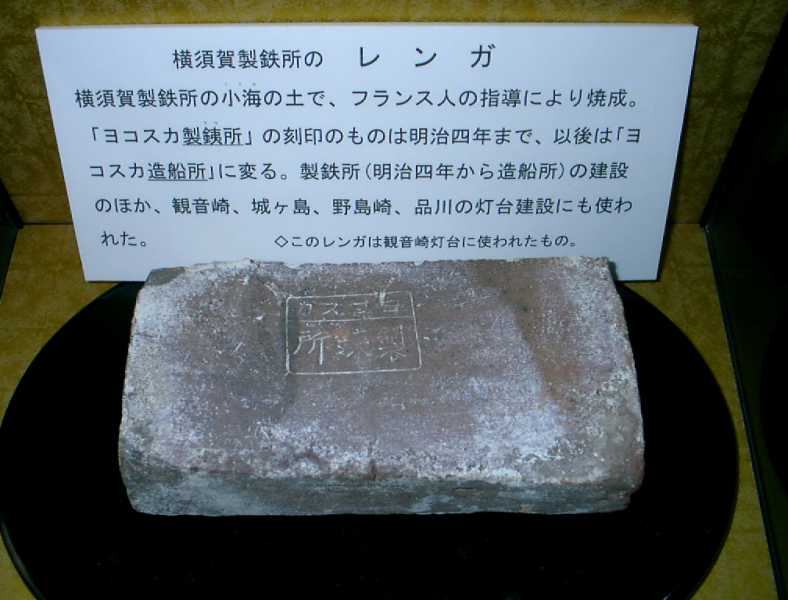 ▲造船所で焼かれたレンガ (東善寺蔵) 刻銘「ヨコスカ 製銕所」 このレンガは、横須賀造船所建設のシンボルとして以前からほしいと思っていたところ、 平成14年秋横須賀市民の協力で入手出来た。観音崎灯台に使われていたもの。 |
Bricks baked at Yokosuka Shipyard (Tozenji collection) We had wanted to have a brick as a symbol of the Yokosuka Shipyard construction for a long time. Then, in the fall of 2002, we were able to obtain one with the cooperation of Yokosuka citizens. This brick was used for the Kannonzaki Lighthouse. |
▼レンガの土を取った小海は、いま米軍基地の中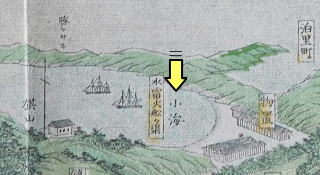 ▲小海 Koumi |
Koumi sea where the soil was collected for the bricks is now inside the US military base. |
幕末に米国と結んだ日米和親条約で、洋式灯台の建設を約束した幕府は、観音崎・城ヶ島・野島崎・品川の四つの灯台を日本最初の洋式灯台として、フランス人フロラン建築課長の指導で建設し明治2年1月に完成・点灯した。4つの灯台はすべて横須賀造船所のレンガで建設された。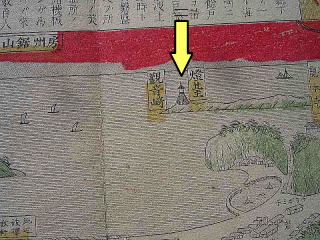 ▲観音崎灯台 (『横須賀明細一覧』より) 最初の灯台は地震によって倒壊し、現在の建物は三代目。 |
In the Japan-US Treaty of Peace and Amity signed at the end of the Edo
period, the shogunate promised to build Western-style lighthouses. They
built four lighthouses at Kannonzaki, Jogashima, Nojimazaki and Shinagawa,
which were completed and lit up in January of 1869, under the guidance
of French Chief Architect Florent.All four lighthouses were built with
bricks from the Yokosuka Shipyard. Kannonzaki Lighthouse (from "Detailed Drawing of Yokosuka") The first lighthouse collapsed in an earthquake, and the present building is the third one. |
| 富岡製糸場で 「ヨコスカ造舩所」のレンガを発掘 富岡市は、富岡製糸場の西繭置所敷地から「ヨコスカ造舩所」という刻印のあるレンガを発掘、と発表した。これまで大きな鉄の水槽が「横浜製作所」の製品であることがわかっていたが、横須賀との関連を示す具体的な事物はなく、富岡製糸場が横須賀のつながりで出来上がっていることを認識する人が少なかった。このレンガで、ようやく少し認識が深まることであろう。 他にたくさんあるわけではないから「見本」として運ばれたと考えられる。 (2013平成25年10月23日) 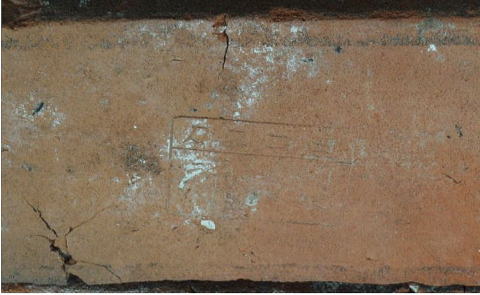 ▲「ヨコスカ造舩所」の刻印がある 「横須賀製鉄所」から「横須賀造船所」に名称が変わったのが明治4年、 富岡製糸場の建設が始まったのも明治4年だから、 まさにこのレンガは明治4年か5年に横須賀で造られたものであろう。 |
Excavation of bricks of "Yokosuka Shipyard" at Tomioka Silk Mill The city of Tomioka announced that it had unearthed a brick with the inscription "Yokosuka Shipyard" on it from the grounds of the Tomioka Silk Mill. Until now, it was known that the large iron water tank was a product of the Yokohama Dockyard & Machinery Works, but there was no concrete evidence of a connection with Yokosuka, and few people were aware of the fact that the Tomioka Silk Mill was built in connection with Yokosuka. This brick will finally make people a little more aware. (October 23, 2013) ▲There is an engraving of "Yokosuka Shipyard". The name was changed from "Yokosuka Ironworks" to "Yokosuka Shipyard" in 1871. The construction of the Tomioka Silk Mill began in 1871. The construction of the Tomioka Silk Mill began in 1871, so these bricks must have been made in Yokosuka in 1871 or 1872. |
| 富岡製糸場の水槽 *ここは現在非公開で一般の見学では見られません* 大きな鉄の煙突(はじめ鉄製・のちにコンクリート製)の手前に蒸気機関を据えた小屋があり、 その手前に大きな水をたたえた水槽をおいた。 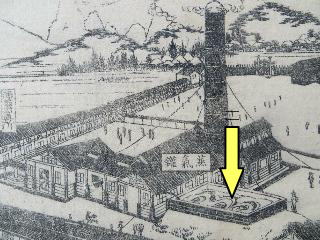 ▲はじめの水槽は四角いレンガ造り (明治6年の絵/東善寺蔵) |
Water tank at the Tomioka Silk Mill * The water tank at the Tomioka Silk Mill is currently closed to the public and cannot be seen by the general public. In front of the large iron chimney (first made of iron, later made of concrete), there was a shed where a steam engine was installed, and in front of it was a large water tank. The first tank was a square brick structure. (Picture from 1873) |
| 富岡製糸場の鉄の水槽 レンガの水槽は漏れるので、後に鉄の水槽に変えた。 リベット打ちで接続された水槽がいつ設置されたのか、まだわからない。 横浜製作所製造 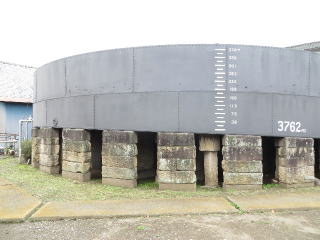 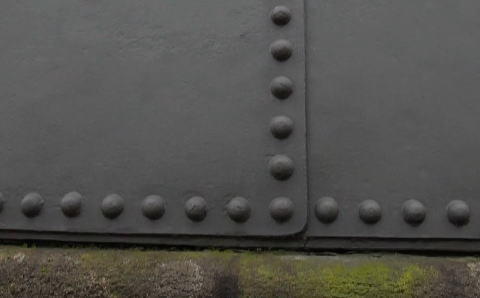 ▲リベットで鉄板をつないでいる。 新しい造船技術の鉄板接合でリベットがきれいに打たれていることから、明治10年代ではないかと推測。 |
Iron water tank at Tomioka Silk Mill The brick water tank leaked, so they later changed to an iron tank. We still don't know when the water tank connected by riveting was installed.Manufactured by Yokohama Manufacturing Company Since the rivets were neatly hammered in the steel plate joints of the new shipbuilding technology, we guessed that it was in the 1877s. |
| 「鉄水槽」の説明板に蒸気機関が出てこない *ここは現在非公開で一般の見学では見られません* 説明板にはこの水槽は「繰糸用の水を蓄えるための水槽…」としか書かれていない。これでは「繭を煮るためだけの水槽」となってしまう。富岡製糸場は横須賀造船所と同じく、蒸気機関を原動力として製糸機械を動かしていた器械製糸だから大量の水を必要とする。その説明がないとおかしい。 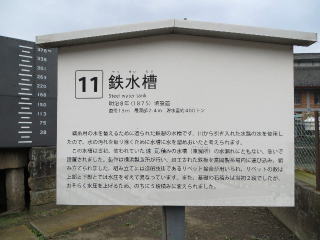 |
The word of "steam engine" does not appear on the explanatory
board of the "Iron Tank. *This area is currently closed to the public and cannot be seen by the general public. The explanatory board only says that this tank is "for storing water for spinning...". This would mean it is "a water tank only for boiling cocoons." Like the Yokosuka Shipyard, the Tomioka Silk Mill was an instrumental silk mill that used steam engines as the driving force to operate the silk machines, so it required a large amount of water. It would be strange if there was no explanation for this. |
| |